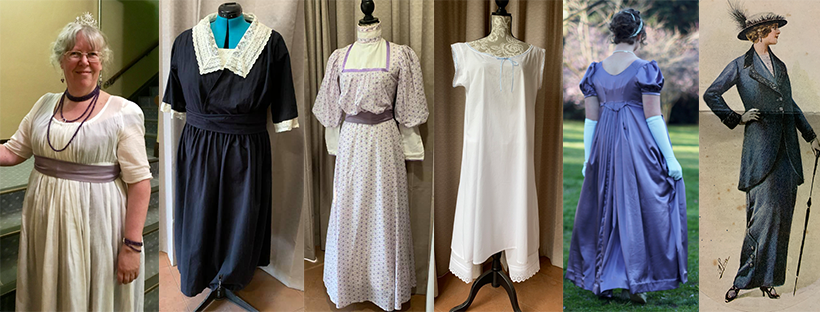A project from 2017
I needed an apron for the Jane Austen Festival as I help out in the kitchen for suppers and wanted to protect my evening dresses.
In researching aprons of the late eighteenth and early nineteenth centuries, there seems to be a number of styles. In the mid-late eighteenth century, before the fashionable waistline rose from the natural waist to under the bust, aprons come in two main styles: an apron without a bib, tied at the waist, and the ‘pinner’ style of apron, with a bib pinned to the bodice.
The apron tied at the waist was a utilitarian item for the working class, and a decorative item for the upper class:



When we move into the Regency era and the higher-waisted dress styles, a common form for working women seems to be the waist apron, often worn with a large fichu or neckerchief, sometimes tucked in to the apron. The neckerchief presumably protects the bodice of the gown or jacket, as the apron protects the skirts. Here are women threshing, a detail of a print published in a series of Costumes of Yorkshire in 1814:

However, aprons with bibs were definitely worn. Although the pinner stye – i.e., the bib pinned to the dress bodice was still worn by some, aprons with some form of shoulder straps and back fastening were also worn. I’m going to hazard a guess that the lighter fabrics of the Regency era were more easily damaged by frequent pinning, and as waist ties don’t work so well with higher bodices, hence the adoption of shoulder straps.
Here’s a Danish cook circa 1805 (image from pinterest). Her apron clearly has straps that go over the shoulder. It also is likely to be linen or cotton, and easily laundered.

And a Costume Parisien fashion plate of 1807, showing a frilled muslin apron as a fashion item:

Black taffeta aprons were quite fashionable for the upper classes; the dark background making particular sense if one was doing fine needlework – or writing letters!

I’ve made mine in a similar style to the black taffeta one above, but in far more practical linen. These probably weren’t worn with evening dress, but let’s just imagine that a lady rushes to the kitchen to avert a crisis during an evening function, and borrows an apron from the cook to assist in serving the dainty queen cakes . . . and fortunately her tiara and pearls match the apron!

I started the apron on 25th October 2016, and finished it on the 10th November. It’s entirely handsewn, including the buttonholes. I used small shell buttons for the first apron, but made a second one with Dorset buttons – a type of button from the era made from a small metal ring with thread wrapped and woven to fill the centre. The last image shows two of the ones I made on the laptop keyboard for scale. I used the larger size for the apron.



Material: White linen IL019 from fabrics-store.com – approx 1 metre from stash
Pattern: drafted myself
Year: 1800-1820ish
